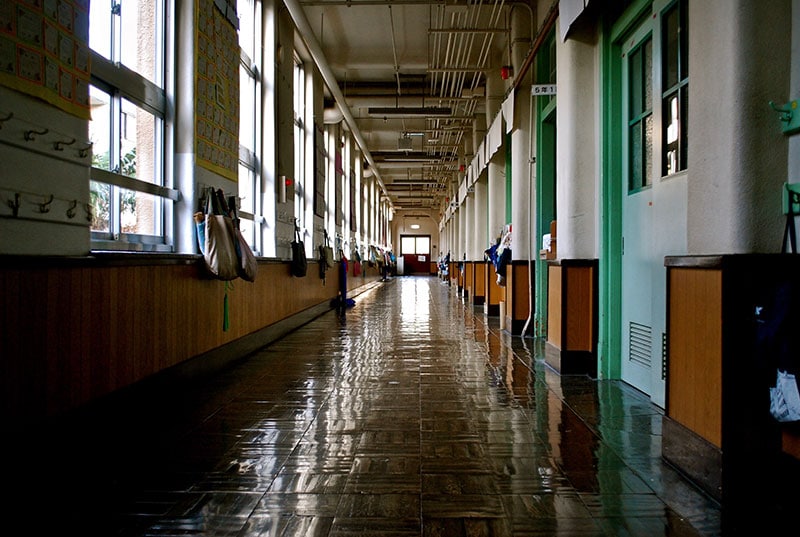Who’s responsible for managing asbestos in schools?
With asbestos having once been an extremely widely used building material in the UK – only finally being banned in this country in 1999 – the substance inevitably remains present in many school buildings that were erected in the 20th century.
And where asbestos is present in a school building, there is a need to manage that asbestos, in accordance with the latest asbestos regulations in the UK.
But do you know who is actually responsible for asbestos-containing materials (ACMs) in your own school premises? Below, we answer the key questions you might have on this subject.

Photo by kyo azuma
Who’s at risk from asbestos in schools?
ACMs within school buildings that are undamaged and in good condition are not believed to pose a significant risk to anyone’s health. In the event, however, of disturbance being caused to such materials, asbestos fibres could be released as a result. This could lead to someone breathing in the fibres, which can bring about serious health risks over time.
So, the individuals within a school who are likely to be at greatest risk of asbestos exposure are those who are especially likely to disturb the substance in the first place.
School caretakers could therefore be at particular risk due to their typical activities on a school site, which can include drilling and fixing. Other contractors who come onto a school site in order to carry out maintenance or installation work may also be at heightened risk, for similar reasons.
It is important to appreciate that while the above individuals may be at greater relative risk, almost anyone who uses a given school building could potentially be at risk from asbestos, in a situation where asbestos fibres are released.
This could include teachers and pupils, who are otherwise unlikely to be at risk from asbestos during the normal course of their activities, provided that any asbestos nearby is in good condition, undisturbed, and well-managed.
Who is the “dutyholder” with responsibility for managing asbestos in schools?
One of the most important aspects of current UK asbestos law, is the concept of the “dutyholder”, as set out in regulation 4 of the Control of Asbestos Regulations 2012 (CAR 2012).
Those regulations define the dutyholder as follows:
(a) every person who has, by virtue of a contract or tenancy, an obligation of any extent in relation to the maintenance or repair of non-domestic premises or any means of access or egress to or from those premises; or
(b) in relation to any part of non-domestic premises where there is no such contract or tenancy, every person who has, to any extent, control of that part of those non-domestic premises or any means of access or egress to or from those premises,
and where there is more than one such dutyholder, the relative contribution to be made by each such person in complying with the requirements of this regulation will be determined by the nature and extent of the maintenance and repair obligation owed by that person.
To put it in simple terms, when it comes to any given non-domestic premises such as a school, the dutyholder is either the owner of the premises, or the person or organisation that has clear responsibility for maintaining or repairing the non-domestic premises.
In school environments, however, the person(s) acting as the dutyholder will vary significantly. Nonetheless, the duty will generally always fall upon a person of executive or senior level.
In secondary schools, examples of dutyholders would include school governors responsible for health and safety, headteachers, or buildings/estates managers. The duty to manage asbestos in primary schools, meanwhile, tends to fall at headteacher or even school bursar level.
School trusts and academy trusts, meanwhile, essentially operate like a business, which means they quite often have an estates department. In these environments, the dutyholder can be an estates director or health and safety director.
It is worth noting that the dutyholder is not allowed to delegate their overall legal duty to comply with the regulations. What they can do, however, is nominate a person often referred to as an “Appointed Person” or “Responsible Person”, in order to manage the risk on their behalf. This is quite often the case within schools where the headteacher may delegate the day-to-day responsibilities for asbestos management to the estates manager.
However, in the event of the asbestos management regulations being breached on a particular school site, it is the dutyholder who would be liable to be prosecuted.
What is the “duty to manage” asbestos?
The “duty to manage” asbestos is a concept contained within regulation 4 of the Control of Asbestos Regulations 2012 (CAR 2012). The person or organisation that has this duty is known as the “dutyholder”, and they are compelled by law to take certain steps to ensure the safe and responsible management of asbestos on their premises.
Those steps include:
- Determining, through reasonable means, whether there are asbestos-containing materials (ACMs) on the site – and if so, the location, amount, and condition of those materials
- Making, and keeping up to date, a record of the location and condition of the ACMs or materials presumed to contain asbestos
- Assessing the risk of anyone being exposed to, and breathing in, the fibres from the identified materials
- Putting together, and putting into action, a plan that makes clear what will be done to manage the risks from these materials
- Periodically reviewing and monitoring the asbestos management plan and the arrangements to act on it, to help ensure the plan continues to be relevant and up to date
- Providing information about the location and condition of the materials to anyone who is likely to work on, or disturb, the materials.
What does the dutyholder have to do in practice in a school?
In order to comply with the above regulations, the typical dutyholder for a school will need to arrange for an asbestos survey to be carried out on their premises.
The information gained from this surveying process will then enable the dutyholder to create a register of the ACMs in the premises. They will also be able to write a management plan outlining the procedures that are to be followed in order to monitor the ACMs’ condition over time.
As we touched on earlier, of the individuals who access and use school premises, it is not necessarily teachers and pupils who are at greatest risk of actually coming into contact with asbestos. It is, instead, caretakers and tradespeople who are likely to be at the highest risk.
Your school’s plan for managing asbestos should therefore contain provisions to make sure anyone who might disturb ACMs is provided with information about the location and condition of these materials. The dutyholder should also make sure suitable training has been given to staff who are likely to disturb asbestos.
What is the role of school staff?
Most of the staff at your school will not have any direct involvement in managing the school buildings – and therefore any asbestos contained within them – and nor will they be directly undertaking maintenance or repair work.
However, your school staff will still have their own important role in managing the asbestos risk at your school. You will therefore need to make them aware of the potential hazards.
You should instruct all your school staff, for instance, to avoid pinning work to walls, or any other similar actions that could result in asbestos disturbance.
Furthermore, you should make clear to your staff that in the event of any damage to school fixtures or fittings that could cause the release of asbestos fibres – such as damage to floor or ceiling tiles, or to column seals in a system-built school – they will be expected to report this damage. This will help ensure the dutyholder knows about any new or altered asbestos risks on the premises as soon as those risks arise, thereby enabling them to act accordingly.
Are you on the lookout for the services and expertise that would allow you to proactively manage the risks asbestos presents on your own school premises? If so, you are welcome to call the Oracle Solutions team to request your fast and free quote from us.

Written by Mark Carter
Mark Carter is a renowned expert in asbestos management, offering clients vital guidance on compliance and safety. His expertise is invaluable for navigating asbestos regulations, ensuring both safety and legal adherence. Mark's role is central in providing effective asbestos-related solutions, helping clients achieve their business objectives with an emphasis on regulatory compliance and safety in asbestos management.
